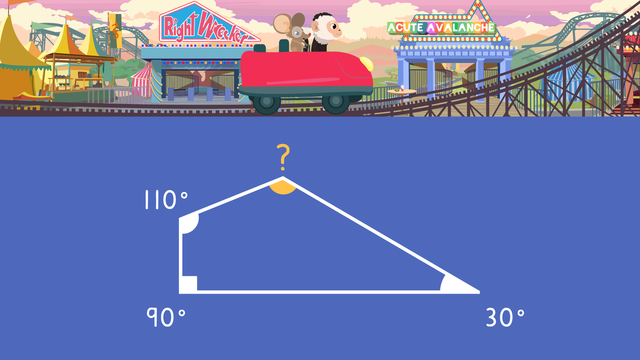Angles and Measuring Angles


Basics on the topic Angles and Measuring Angles
Measuring Different Types of Angles
We can see angles everywhere in our daily lives. When we open a door, an angle is formed. When we use scissors, an angle is formed as we open and close the scissors. Even the letter “V” has an angle. But what are angles?
Angles are made when two straight lines meet. The point at which the lines meet is called the vertex. Therefore, the opening between the lines can be measured in degrees using a protractor. A protractor is a device for measuring angles. Protractors can also be used to draw angles. The opening of the angle is called an arc.
Types of Angles – Revision
The size of the arc is used to determine the type of angle. Angles that measure less than 90 degrees are called acute angles while those that measure more than 90 degrees but less than 180 degrees are called obtuse angles. A 90-degree angle is called a right angle.
| Angle Name | Size |
|---|---|
| Acute Angle | Less than 90 degrees |
| Right Angle | Exactly 90 degrees |
| Obtuse Angle | Greater than 90 degrees but less than 180 degrees |
| Straight Angle | Exactly 180 degrees |
Measuring Angles with a Protractor
We can measure and classify angles using a protractor. Protractors look like half circles. On the straight edge, there is a line called the baseline and a hole or a point on that baseline called the origin. These are essential in being able to measure an angle accurately. Therefore, it is important to know how to use a protractor.
To measure an angle using a protractor, follow these steps:
Step 1: Line up the origin (center hole) of the protractor with the angle’s vertex making sure that one line of the angle is lined up properly with the baseline of the protractor. The other line of the angle should be somewhere inside the protractor.
Step 2: Now look at where the line that is above or below the baseline of the protractor lines up with the measurement lines on the protractor. If you are measuring the angle from the left side, read the measurements on the outside of the protractor. If you are measuring an angle that opens from the right side, read the inner measurements.
Measuring Angles – Summary
Let’s repeat what we learned about measuring angles today.
Measuring angles can be done with an instrument called a protractor. To use the protractor, one line of the angle must be lined up with the baseline of the protractor and the vertex of the line must be placed on the origin of the protractor. We then read the protractor based on the opening of the angle.
Be sure to test and expand your knowledge on measuring angles with the other videos in this topic as well as our interactive exercises!
Transcript Angles and Measuring Angles
Nia found a skateboard in the attic and is learning how to do some cool tricks! She is practicing making turns with the board. We can track her progress by using a special tool called a PROTRACTOR. : "Angles and Measuring Angles" Nia's turns will be measured by the angles they create. Remember, angles are made by two lines that meet at an endpoint, called the VERTEX. We name the angles by how wide the opening of the ARC is and measure these in degrees. Angles can be acute(...), right,(...)obtuse(...), or straight(...) depending on the opening size. Can you point to the opening, or arc, of each angle? This is the area we need to measure to know what type of angle we have. While we measure Nia’s first turn, let’s take a look at the parts of a protractor. Look at the bottom straight edge(....)We call this the "baseline". It looks familiar, doesn’t it? This ruler is what we will use to make straight lines and it also helps measure the angle openings. In the center of the baseline, you will see a "black dot surrounded by a circle." In order to measure an angle, place this area directly over the VERTEX and line up the bottom line with the zero on the far left side. Now look at the rounded part of the protractor, called the SCALE. What do you notice about the numbers on the scale? The scale has two sets of numbers from zero to one hundred eighty, going in opposite directions. The numbers on the scale are grouped by tens with smaller dashes that count by fives. To measure, use the set of numbers on the scale that are facing the SAME DIRECTION as your angle opening. Since Nia is facing LEFT, we will use the numbers on the OUTER scale. To determine the degrees of the turn, look at the SECOND line that makes up the angle. What number on the scale does this line intersect with? The line is crossing through the number THIRTY on the outer scale. Nia moved the skateboard thirty degrees and made an acute angle. Let’s see how far she has moved the board on her next try. First, place the center of the baseline on the vertex and line up with the zero on the OUTER scale. Next, you want to see where the top line crosses. What do you notice about where this line intersects? (...) It measures ninety degrees and makes a right angle. Nia has turned her board HALFWAY! On this turn, we can tell that Nia has gone more than ninety degrees because the opening is wide. Using the protractor, we can find the exact measurement of this obtuse angle. We line up the protractor the same way every time(...) bottom line is on zero. When we look at the top line, we see that it does not intersect on a number. How can we use what we know to solve for this measurement? (...) We can find the number that is right BEFORE and right AFTER the intersecting line. The numbers are one hundred thirty and one hundred forty. What number is exactly halfway between these two? One hundred thirty-five! More determined than ever, she gives it another try! When you line up the protractor on this turn, you can see it makes a one hundred eighty degree angle, which is a straight line! Nia has turned the skateboard in the other direction! Remember(...) We use a tool called a protractor to measure the size of an angle. We measure by lining up the center of the baseline with the vertex AND the bottom line with the zero on the scale. Then, we count up from zero until we find where the other line intersects with the protractor. WATCH OUT, NIA! Looks like we need to practice going down the ramp!
Angles and Measuring Angles exercise
-
What's the angle of Nia's turn?
HintsThe horizontal line is aligned with 0. Look to see what number the other line is aligned with.
The angle opens to the left, so look at the numbers that count from left to right.
Look at the numbers on the outermost rim of the protractor.
SolutionThe protractor is correctly aligned because the dot is where the two lines meet, and the horizontal line is aligned with the 0.
The angle opens to the left, so use the numbers that start counting from the left. These are the numbers on the outer rim of the protractor.
See where the angle's line crosses the protractor. It is halfway between 70 and 80, so the line crosses the protractor at 75.
So, the angle is 75$^\circ$.
-
Name the different types of angles.
HintsAn acute angle measures less than 90$^{\circ}$.
An obtuse angle measures greater than 90$^{\circ}$.
A right angle measures 90$^{\circ}$.
SolutionTo solve this, you can check the exact measurements of each angle. You can also just look to see if they are less than, equal to, or greater than 90$^\circ$.
The first angle is exactly 90$^\circ$, so it is a right angle.
The second angle is greater than 90$^\circ$, so it is an obtuse angle.
The third angle is greater than 90$^\circ$, so it is an obtuse angle.
The fourth angle is less than 90$^\circ$, so it is an acute angle.
The final angle is less than 90$^\circ$, so it is an acute angle.
-
Which angles show the given degrees?
HintsLook to see which way the angle opens to determine whether to use the outer or inner set of numbers.
If the angle opens to the left, start from the 0 on the left and use the outer ring of numbers.
If the angle opens to the right, start from the 0 on the right and use the inner ring of numbers.
SolutionThese two angles both measure 125$^\circ$.
- The first one opens to the left. Use the outer ring of numbers to see that the angle aligns with the 125$^\circ$ mark.
- The second one opens to the right. Use the inner ring of numbers to see that the angle aligns with the 125$^\circ$ mark.
-
What is the measure of this angle?
HintsFirst, check whether you are using the numbers starting from the left or the right of the protractor.
Find where the angle crosses the protractor to figure out the measurement.
SolutionThe angle opens from the right, so read the numbers that start with 0 on the right. These are the smaller numbers on the protractor.
The line crosses the protractor halfway after 140, so count 5 more. 140, 145.
So, the angle is 145$^{\circ}$.
-
Is the protractor correctly lined up?
HintsA protractor is correctly aligned when:
- The horizontal line of the angle is aligned with the 0 line on the protractor.
- The dot in the middle of the bottom of the protractor is in the corner of the angle.
Check to see where the protractor's dot aligns with the angle.
SolutionA protractor is correctly aligned when both:
- The horizontal line of the angle is aligned with the 0 line on the protractor.
- The dot in the middle of the bottom of the protractor is in the corner of the angle.
In this problem, the dot was not in the corner of the angle. Nia needs to move the protractor so the dot is in the angle's corner, as shown in the image on the right.
-
Find the measurement for each angle.
HintsFor each angle, first look to see whether it opens to the right or the left.
Figure out if the angle is acute or obtuse to help you find the correct measurement.
Count by 10's and 5's to find where the angle crosses the protractor.
SolutionFor each angle, first look to see whether it opens to the right or the left.
Then, look to see where the line of the angle aligns with the protractor. Count by 10's and 5's to find the measurement.


















I just spelled random words lol